Film Festival
NO/GLOSS Leeds
The weekend of the 8th & 9th of September saw the launch of Leeds’ first DIY and experimental film festival No/Gloss. As a big fan of film festivals with half-an-eye on experimental film this was pretty exciting. I was only able to attend for one of the two days but I had a great time there.
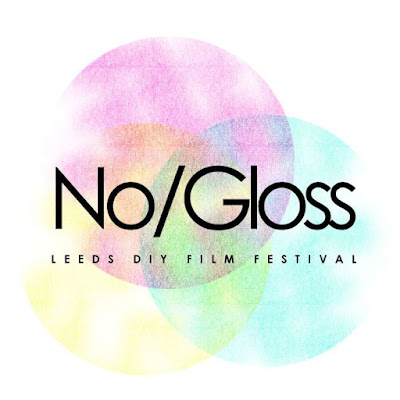
Keeping with the DIY aesthetic, the organisers held it in Wharf Chambers - a co-operatively run Arts-space near(ish) to the Corn Exchange, Leeds. This meant that festival goers could take advantage of the Sam Smiths beer on offer as well as some pretty tasty vegan food. A crowd of film-fans had descended like hungry-wolves on the black-bean paté sandwiches (would hungry wolves eat black bean paté? Not so sure…) but I can vouch for the herb tofu. Great stuff.
The set-up in place at the main screen saw films being shown in three sessions with short breaks between each batch of films. There was a second screen as well, with a long list of shorts that were on a rolling playlist. Sadly, this screen got a bit lost amid the bar, food-counter and conversation of the main room so I didn’t really see very much that was shown on it. But the glimpses I caught did seem interesting.
I’ll write a separate post to review some of the films over the next couple of days, so for now I’ll content myself with saying that the films were varied and interesting. The speed which the schedule see-sawed between funny and depressing did seem a little awkward - finished watching a gritty investigation on homelessness in Manchester? Here’s something funny! - but perhaps that served to emphasise the sheer variety. I’ll put a couple of my favourites at the end.
All in all, NO/GLOSS was a triumph (from the point of view of a punter, at least). And I sincerely hope we’ll see future instalments of this welcome addition to Leeds’ busy cultural calendar.
Some of the best shorts:
Probably my absolute favourite. Bottle by Kirsten Lepore. One of those films that reminds you what fabulous things you can do with a little patience and a whole lot of imagination. A lovely film.
Post Fracas by Xander Robbin is a completely bonkers look at the feelings experienced by a family after being humiliated on a TV-gameshow. A lot of fun
POST FRACAS from Xander Robin on Vimeo.
Surface ii by Sam Spreckley is a beautiful abstract piece. Mesmerising.
Surface ii from sam spreckley on Vimeo.
Juan of the Dead
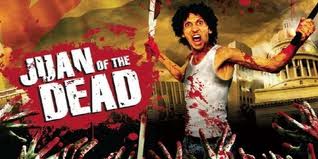
A few months ago, towards the end of last year, the Leeds International Film Festival announced a rather exciting looking UK premiere in the shape of the world’s first Cuban zombie film Juan of the Dead. Sadly, given that I was volunteering at the time (and watching as many films as I could cope with…) I missed it. Given that foreign cult films are sometimes ridiculously slow to appear on DVD here in the UK, I thought I’d missed it altogether. So it was a pretty nice surprise to see the fabulous Bradford Film Festival schedule it as part of their After Dark strand of horror films this year.
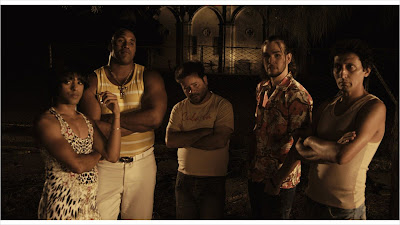
As a lover of many things Spanish/LatinAmerican and all things Zombie, perhaps I was somewhat determined to enjoy this. Even so, sometimes that hyped excitement is the surest way to guarantee disappointment. After all, when you’re looking forward to a film that much it’s going to be hard for it to meet expectations (this is also a worry of mine about Iron Sky, the much-hyped Nazis-on-the-moon adventure…). Thankfully, JotD offered no such disappointment. It was great fun from start to finish.
Juan is a tongue-in-cheek zombie killing rampage with plenty of laughs, some fun gore and not a lot in the way of horror. It’s decidedly more in the Dead Snow and Shaun of the Dead lines than Dawn of the Dead or other more (ahem) ‘serious’ zombie films - this was probably a sensible choice: straight-faced zombie horror can be pretty hard to pull off, especially with a comparatively inexperienced cast (French suburban zombie masterpiece La Horde shows how well it can be done though!). Anyway, Juan sensibly balances laughs and splatter, with the obligatory bit of soul-searching and character improvement.
The basic premise is left beautifully stark. Havana is overrun with zombies. Juan and friends are trying to survive. That’s about all there is to it. Like many of the classics they don’t waste much time on life-before-zombies and they certainly don’t bother explaining where the zombies come from - although the TV reporter blames American imperialists, a neat joke on both Cuban news/propaganda and the (modern) zombie’s links to American consumerism. For the most part it just throws us into the middle of the fray as the Juan, his estranged daughter, his best friend and a couple of others start bashing, slashing, smashing and splattering zombies.
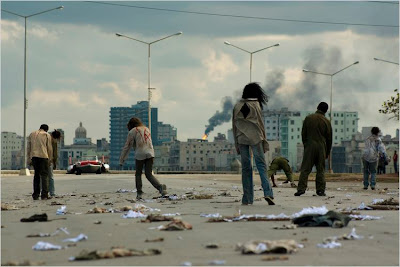
It’s not perfect. But who really expects perfection from a zombie flick? The plot is essentially pretty episodic: Juan and friends go to one place, kill zombies. Another place, kill zombies. Go home. Go out. Kill Zombies. Etc. etc. Luckily it’s all carried out with such obvious enthusiasm that it never really gets boring. It’s slightly spoiled by some astonishingly crappy CGI though. Before computer graphics, designers had to find a convincing way to show something or just not show it. If only this were still true. Shots like a helicopter smashing into Cuban government buildings were obviously prohibitively expensive to shoot properly so would have been better left out entirely. Instead the computer generated helicopter just looks cheap.
The gore’s good though! Some nice splatters, severed limbs and oozing wounds show just what fun you can have with real physical special effects. And, even if it is episodic, some of the episodes are so damn good that you can forgive them entirely: one scene sees the heroes naked, unarmed and handcuffed to a zombie in the back of a van… There are lots of wry jokes at the Cuban regime and it’s claims - the zombies are referred to as dissidents throughout - and one of the characters carries both a Cuban and a US flag to wave depending on who wins. It’s also suitably cavalier with its characters: several central characters meet gruesome ends and, at the beginning at least, the gang seem to accidentally kill as many humans as they do zombies (accidentally shooting an old lady with a harpoon…).
Overall, it’s the enthusiasm that holds this film together. It’s made by people clearly enjoying the chance to make the first Cuban zombie film and their enthusiasm is infectious. Juan is somewhat uneven but so are most zombie films. It’s generally a lot of fun.
(The Bradford Film Festival is screening it again on Sunday 22nd and the film will get a DVD release on 4th June. Hurrah!)
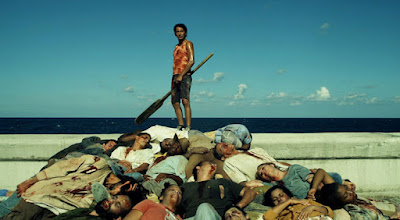
Suspiria
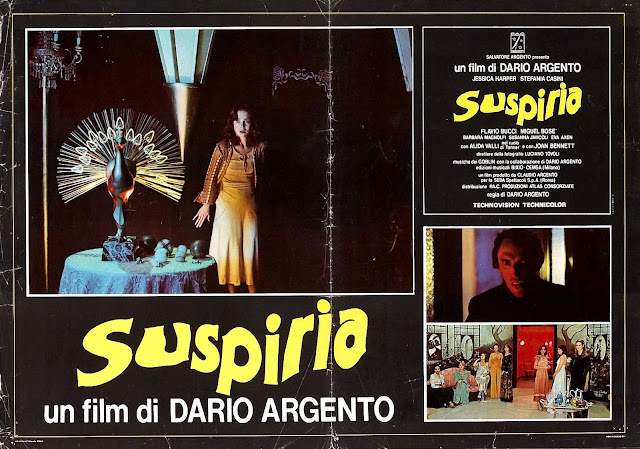
SUSSSSSSSSPIRIA! On a great big screen!
Last night, after a week of Argento film’s, I got to see his spellbinding masterpiece Suspiria on a cinema-screen in the National Media Museum as part of the Bradford International Film Festival. I’d obviously wound myself into a bit of a frenzied excitement about it through the week and it certainly did not disappoint.
Every time I hear someone say they choose to watch films at home rather than at the cinema, mostly due to all the other film-goers, I think to myself “You’ve just been going to the wrong films with the wrong people!”. Last night’s audience had almost all seen the film before and sat in captivated silence, tittering nervously at the occasional gentle comic moments and - even before fun - audibly anticipating oncoming moments of horror. If a bad crowd can ruin a film, a great crowd can make one. Not that Suspiria needed any help in that respect…
My first and only minor gripe is that it was very sadly the cut version. This was an original cinematic print taken from the Media Museum’s extensive archive and so was a print of the X-rated version that the BBFC approved in 1977, after demanding 1m13 of cuts (Cut info at Melon Farmers). Now, to those not familiar with horror film, particularly of BBFC-butchered horror film of a couple of decades ago, 1m13 might not sound very much. It also might not sound so important if I tell you that the full extent of the cuts involved removing a series of close-ups of stabbing, someone struggling through barbed wire and a dog biting a man’s throat. Cuts, however, do make a difference to the rhythm and pacing of a film. Suspira is a film that, like so many Argento, thrives on the atmospheric build-up, to the point that the death scenes actually become a kind of release. For a couple of them to be dramatically shortened here was a shame.
Still, whilst that was the downside to it being an original theatrical print, there were certainly upsides. The first (and some would reject this) was that the image did have a wonderfully scratchy look. Anyone who’s seen a film in cinemas that was filmed entirely in HD-digital knows how clinical and sterile it can look (I’m looking at you Public Enemy!) and, whilst I’m not suggesting scratchy is the way forward, there was certainly something enjoyable about watching a 70s film I thought I’d never see in a cinema, complete with all the visual wear and tear that a 30 year old 35mm reel has experienced (even if carefully looked after by the Museum)
The second benefit was the sound. The sound! Anyone who’s seen Suspiria, an Argento film or evne read any of my blog from this week will know that sound makes up an enormous part of Argento’s films. Suspiria is (arguably) the very best of these, scored again by the ever wonderful Goblin, and positively throbs, jangles and crashes at you. Original print, combined with cinema sound system made it an utterly fantastic experience that I’m sure I’ll never be able to repeat (especially as most commercial releases saw the soundtrack savagely remixed).
The film itself is a whirling, semi-nonsensical, breathtaking journey of colour and sound, moving from the giallo murder-mystery into something a whole lot more supernatural, with savagely brilliant results. I really don’t want to say too much more about the actual film, save to say that it is pretty much the best example of all the techniques I’ve been seeing this week in all his other films. It’s not perfect (the scene-with-the-bat is awful) but it’s brilliant, beautiful and should be seen by everyone.
Argento Week's FINALE!

Of course, all that Dario Argento film watching wasn’t just for fun, it was all to build up to the fantastically exciting screening of Suspiria tonight in the Bradford International Film Festival. It’s hardly going to be worth me reviewing it - I love the film so much already a review will probably be just a string of superlatives and smiley faces - but I’m hoping that, given the big screen treatment, I’ll find even more to love about it!
Dario Argento week!

CC licenced photo by Brian Eeles via Wikimedia
This Sunday, the National Media Museum, as part of the Bradford International Film Festival’s Widescreen Weekend - a festival strand devoted to screening classic examples of gorgeously presented films - are showing Suspiria by Italian director Dario Argento.
Now I love the Dario Argento films I’ve seen. More than that, I consider Suspiria one of my favourite films ever. Although the story might not be anything too remarkable, the visual style and the brooding music add up to create one of the most beautiful, tense and atmospheric pieces of film I’ve ever seen. And I never thought I’d get to see it on a big screen!
Needless to say, I am slightly very excited!
So, between now and Sunday, what better way to anticipate the event than by watching seven other of Argento’s films? And writing about them here, of course.
Over the next seven days, I shall watch (in an as yet undecided order)
Profondo Rosso, The Bird with the Crystal Plumage, Opera, 4 mosche di velluto grigio, Tenebrae, Cat O’ Nine Tails and Phenomena.
Buy Tickets to Supiria
Check out the Bradford International Film Festival